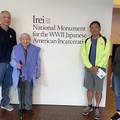The following article was written in response to The Community Day of Remembrance, an annual public program held at the Japanese American National Museum on February 16, 2008 to mark President Roosevelt's signing of Executive Order 9066 on February 19, 1942, that authorized the unconstitutional forced removal of 120,000 Japanese Americans from the West Coast and Hawai`i during World War II.
This year's program recognized the grassroots activism starting with Japanese Americans testifying at government-sanctioned hearings in 1981, through letter writing and lobbying for redress, to the current demand for compensation for Japanese Latin Americans.
Click here for more information about redress, related public programs, and access to additional resources. -ed.
As I sat watching the Day of Remembrance program at the Japanese American National Museum last week, I was glad I gathered my energy on a lazy, sunny Saturday afternoon after a long run to get in my car and drive to Little Tokyo. My first thought was how wonderful to be surrounded by all the standard bearers in the redress movement from nearly 30 years past – people like Alan Nishio, Jim Matsuoka, Frank Emi, Phil Shigekuni (and the list goes on and on). I was also thrilled to see signs of a new generation willing to continue to carry the banner, gathered together by Traci Kato-Kiriyama who led the program by staying quietly in the background letting those who were there tell their stories.
And the stories were many. Frank Emi chronicled his life from prison to pardon to his first NCRR meeting. Kay Ochi told how one little flyer changed her life (and if you know how many hours Kay puts into NCRR, you know exactly what she means). Jim Matsuoka described how his fight began by wanting to give a certain camp-loving Senator (S.I. Hayakawa) a piece of his mind, or a kick in the butt. Kathy Masaoka reflected back to the day after 9-11 when she felt an eerie connection between the hatred in the air toward Arab Americans and how it must have felt for her parents after Pearl Harbor.
As these stories were being told, I tried to think back 20 years when the Civil Liberties Act of 1988, or redress bill, was signed. My father had passed away, and the employment agency office he and my mother ran in Little Tokyo was long closed. My mom had retired to a condominium in Marina del Rey and hardly even went to J-town anymore. For myself, having grown up in a largely white community in Pasadena, I didn’t pay much attention to the redress movement. I only remember that I was shocked to learn that my elderly mother had written a letter to President Reagan urging him to sign the redress bill. It was all the more unexpected because my mother’s usual life consisted of clipping coupons, going shopping, and listening to Joe Pyne on the radio. Aside from voting, the act of writing a letter to the President was the most politically proactive thing she ever did in her life.
The day her redress check arrived was one of the happiest moments I recall in my mom’s later life. For someone who struggled her whole life raising nine children, this money must have meant a lot to her (I’m sure the apology meant a lot, too, but she never talked about camp so I never got a chance to ask her). She called my sister and me and told us she was taking us out to dinner, “her treat.” Going out to eat with my mom usually meant fish sandwiches at McDonald’s or, if we were lucky, a burger at Bob’s Big Boy, but for this occasion we got to go to Killer Shrimp, one of the more expensive restaurants (in my mom’s estimation, that is) in Marina del Rey. As usual, we spoke little over dinner, but I remember congratulating her for writing that letter, still not realizing back then the massive effort it took from lawyers, lobbyists, congressmen and most of all – grassroots activists (people not unlike my mom) – to make redress a reality.
Knowing what I do today, I am all the more impressed by the tenacious work of the redress activists who roamed Aratani Hall on Saturday. Although it’s sad to note that many of the champions from the past (like Edison Uno, Bert Nakano, Michi Weglyn, Sue Embrey and too many others) are gone, I realized that it’s not too late to honor those still around, including those not able to attend Saturday’s event, like Lillian Nakano, Aiko Herzig-Yoshinaga, William Hohri, among countless others. Fortunately, the Japanese American National Museum will pay tribute to all of them at their annual dinner on April 19.
As I was leaving, I spotted Kay Kaneko sitting in the corner by the reception desk. Kay, who was visiting from Holualoa, Hawai’i, is a member of the celebrated Uno family. Edison Uno was the first person to call out for monetary reparations way back in 1970, when it was considered a stupid and crazy idea. Amy Ishii, another Uno family member, is fondly remembered in Los Angeles as one of the first Manzanar Committee members. Kay is the family’s historian, but the Uno history has yet to be unlocked from her files. It would sure be nice if someone helped her tell it. It’s too easy to forget people like her courageous family.
We owe a tremendous debt to them and all the many others who fought for redress and the recognition of the wrongs committed by the government against our families. We can do it by participating, listening and sharing each other’s stories. It’s up to us to pay them back. Besides what I personally owe, I’d like to throw in a little for my mom, whose redress check most likely meant more to her than I will ever know.
* This article was originally published in the Rafu Shimpo.
© 2008 Sharon Yamato





